Detailed Comparison: IFRS and GAAP Accounting Standards and Practices
VerifiedAdded on 2020/10/12
|7
|1467
|135
Report
AI Summary
This report provides a comprehensive comparative analysis of International Financial Reporting Standards (IFRS) and Generally Accepted Accounting Principles (GAAP). It explores the fundamental differences between the two accounting frameworks, including their approaches to inventory valuation (LIFO, FIFO), income reporting, and the overall conceptual framework. The report highlights that GAAP is rule-based while IFRS is principle-based. It examines the implications of these differences for financial statement users, particularly in the context of global financial markets and the convergence efforts between the two standards. The report also discusses key issues in the global conceptual framework and provides relevant references to support its analysis.
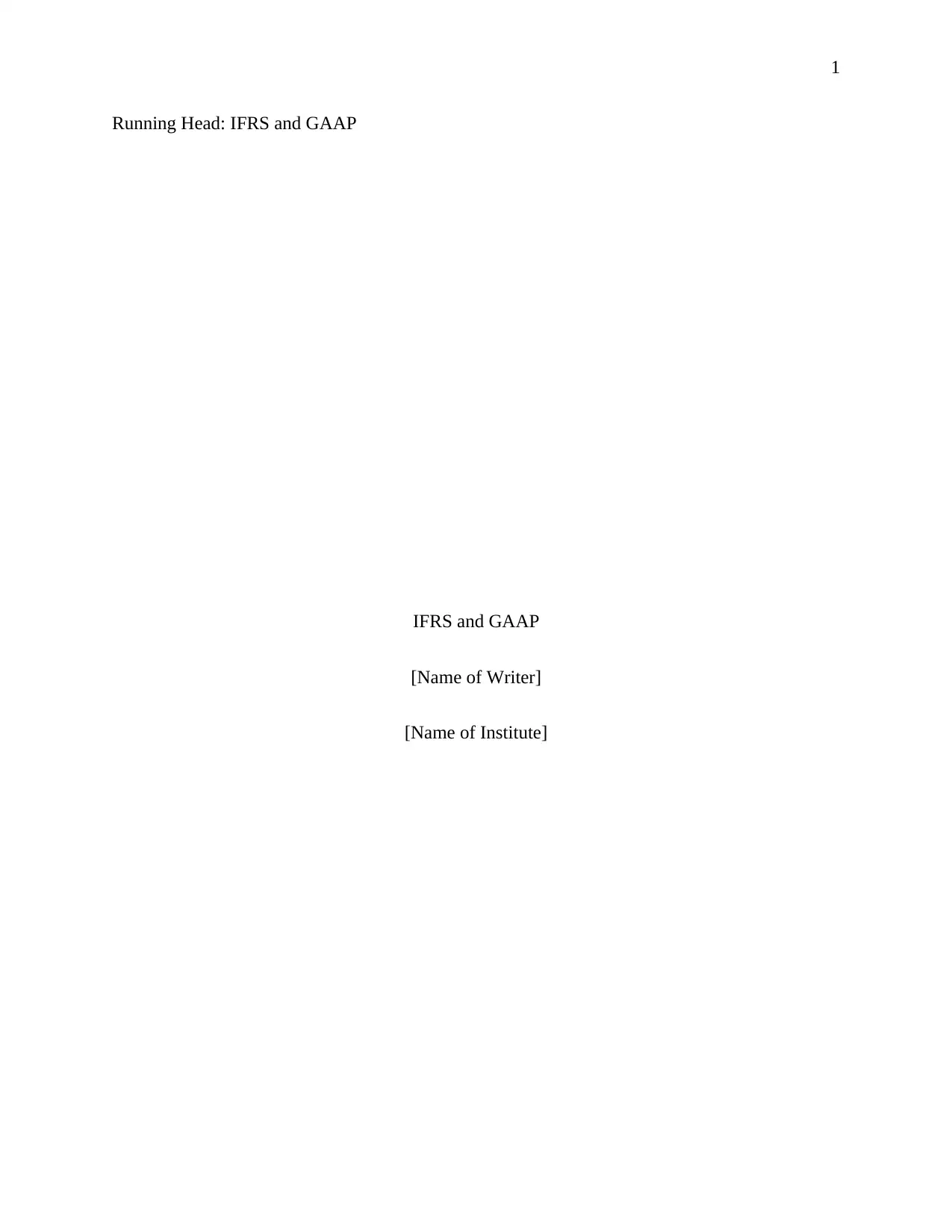
1
Running Head: IFRS and GAAP
IFRS and GAAP
[Name of Writer]
[Name of Institute]
Running Head: IFRS and GAAP
IFRS and GAAP
[Name of Writer]
[Name of Institute]
Paraphrase This Document
Need a fresh take? Get an instant paraphrase of this document with our AI Paraphraser
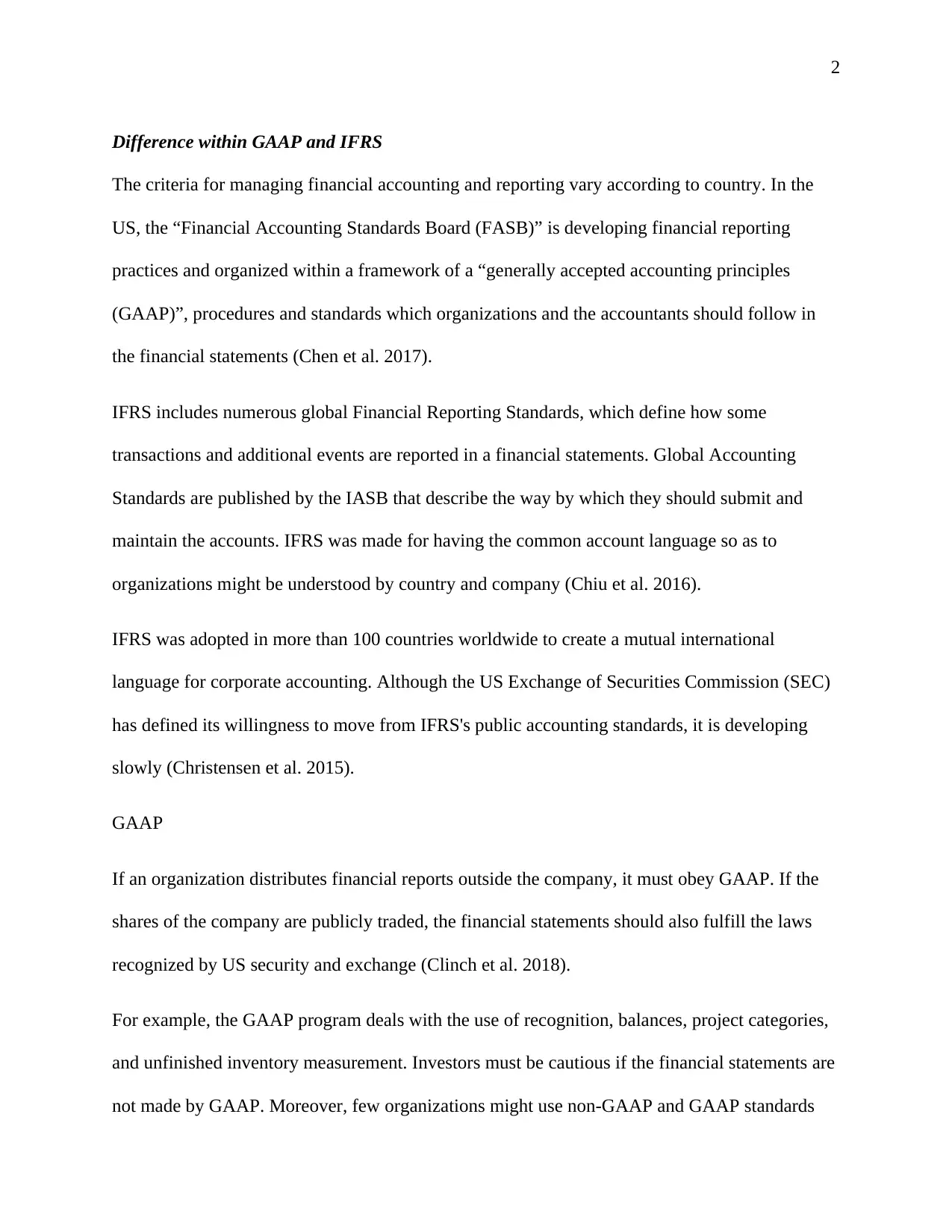
2
Difference within GAAP and IFRS
The criteria for managing financial accounting and reporting vary according to country. In the
US, the “Financial Accounting Standards Board (FASB)” is developing financial reporting
practices and organized within a framework of a “generally accepted accounting principles
(GAAP)”, procedures and standards which organizations and the accountants should follow in
the financial statements (Chen et al. 2017).
IFRS includes numerous global Financial Reporting Standards, which define how some
transactions and additional events are reported in a financial statements. Global Accounting
Standards are published by the IASB that describe the way by which they should submit and
maintain the accounts. IFRS was made for having the common account language so as to
organizations might be understood by country and company (Chiu et al. 2016).
IFRS was adopted in more than 100 countries worldwide to create a mutual international
language for corporate accounting. Although the US Exchange of Securities Commission (SEC)
has defined its willingness to move from IFRS's public accounting standards, it is developing
slowly (Christensen et al. 2015).
GAAP
If an organization distributes financial reports outside the company, it must obey GAAP. If the
shares of the company are publicly traded, the financial statements should also fulfill the laws
recognized by US security and exchange (Clinch et al. 2018).
For example, the GAAP program deals with the use of recognition, balances, project categories,
and unfinished inventory measurement. Investors must be cautious if the financial statements are
not made by GAAP. Moreover, few organizations might use non-GAAP and GAAP standards
Difference within GAAP and IFRS
The criteria for managing financial accounting and reporting vary according to country. In the
US, the “Financial Accounting Standards Board (FASB)” is developing financial reporting
practices and organized within a framework of a “generally accepted accounting principles
(GAAP)”, procedures and standards which organizations and the accountants should follow in
the financial statements (Chen et al. 2017).
IFRS includes numerous global Financial Reporting Standards, which define how some
transactions and additional events are reported in a financial statements. Global Accounting
Standards are published by the IASB that describe the way by which they should submit and
maintain the accounts. IFRS was made for having the common account language so as to
organizations might be understood by country and company (Chiu et al. 2016).
IFRS was adopted in more than 100 countries worldwide to create a mutual international
language for corporate accounting. Although the US Exchange of Securities Commission (SEC)
has defined its willingness to move from IFRS's public accounting standards, it is developing
slowly (Christensen et al. 2015).
GAAP
If an organization distributes financial reports outside the company, it must obey GAAP. If the
shares of the company are publicly traded, the financial statements should also fulfill the laws
recognized by US security and exchange (Clinch et al. 2018).
For example, the GAAP program deals with the use of recognition, balances, project categories,
and unfinished inventory measurement. Investors must be cautious if the financial statements are
not made by GAAP. Moreover, few organizations might use non-GAAP and GAAP standards
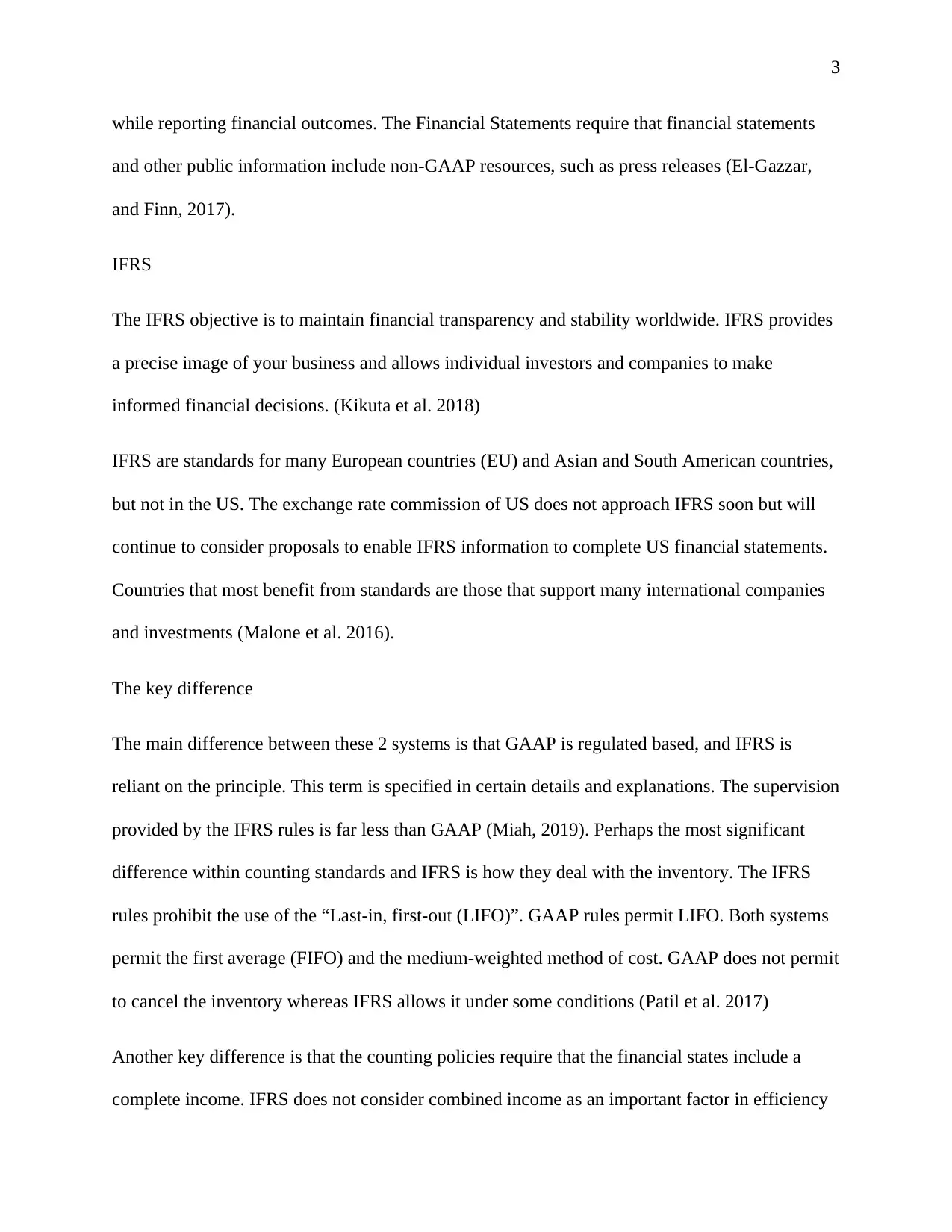
3
while reporting financial outcomes. The Financial Statements require that financial statements
and other public information include non-GAAP resources, such as press releases (El-Gazzar,
and Finn, 2017).
IFRS
The IFRS objective is to maintain financial transparency and stability worldwide. IFRS provides
a precise image of your business and allows individual investors and companies to make
informed financial decisions. (Kikuta et al. 2018)
IFRS are standards for many European countries (EU) and Asian and South American countries,
but not in the US. The exchange rate commission of US does not approach IFRS soon but will
continue to consider proposals to enable IFRS information to complete US financial statements.
Countries that most benefit from standards are those that support many international companies
and investments (Malone et al. 2016).
The key difference
The main difference between these 2 systems is that GAAP is regulated based, and IFRS is
reliant on the principle. This term is specified in certain details and explanations. The supervision
provided by the IFRS rules is far less than GAAP (Miah, 2019). Perhaps the most significant
difference within counting standards and IFRS is how they deal with the inventory. The IFRS
rules prohibit the use of the “Last-in, first-out (LIFO)”. GAAP rules permit LIFO. Both systems
permit the first average (FIFO) and the medium-weighted method of cost. GAAP does not permit
to cancel the inventory whereas IFRS allows it under some conditions (Patil et al. 2017)
Another key difference is that the counting policies require that the financial states include a
complete income. IFRS does not consider combined income as an important factor in efficiency
while reporting financial outcomes. The Financial Statements require that financial statements
and other public information include non-GAAP resources, such as press releases (El-Gazzar,
and Finn, 2017).
IFRS
The IFRS objective is to maintain financial transparency and stability worldwide. IFRS provides
a precise image of your business and allows individual investors and companies to make
informed financial decisions. (Kikuta et al. 2018)
IFRS are standards for many European countries (EU) and Asian and South American countries,
but not in the US. The exchange rate commission of US does not approach IFRS soon but will
continue to consider proposals to enable IFRS information to complete US financial statements.
Countries that most benefit from standards are those that support many international companies
and investments (Malone et al. 2016).
The key difference
The main difference between these 2 systems is that GAAP is regulated based, and IFRS is
reliant on the principle. This term is specified in certain details and explanations. The supervision
provided by the IFRS rules is far less than GAAP (Miah, 2019). Perhaps the most significant
difference within counting standards and IFRS is how they deal with the inventory. The IFRS
rules prohibit the use of the “Last-in, first-out (LIFO)”. GAAP rules permit LIFO. Both systems
permit the first average (FIFO) and the medium-weighted method of cost. GAAP does not permit
to cancel the inventory whereas IFRS allows it under some conditions (Patil et al. 2017)
Another key difference is that the counting policies require that the financial states include a
complete income. IFRS does not consider combined income as an important factor in efficiency
⊘ This is a preview!⊘
Do you want full access?
Subscribe today to unlock all pages.

Trusted by 1+ million students worldwide
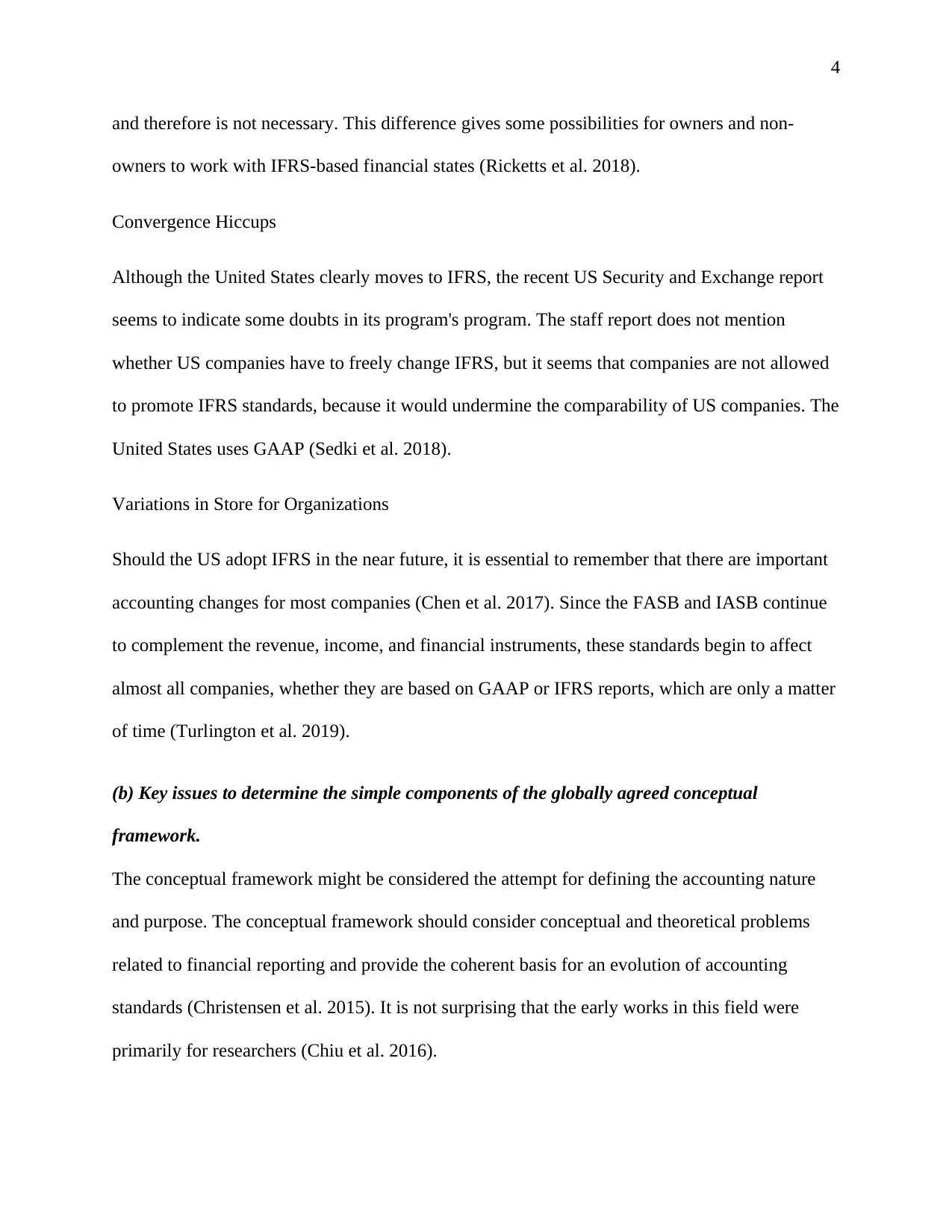
4
and therefore is not necessary. This difference gives some possibilities for owners and non-
owners to work with IFRS-based financial states (Ricketts et al. 2018).
Convergence Hiccups
Although the United States clearly moves to IFRS, the recent US Security and Exchange report
seems to indicate some doubts in its program's program. The staff report does not mention
whether US companies have to freely change IFRS, but it seems that companies are not allowed
to promote IFRS standards, because it would undermine the comparability of US companies. The
United States uses GAAP (Sedki et al. 2018).
Variations in Store for Organizations
Should the US adopt IFRS in the near future, it is essential to remember that there are important
accounting changes for most companies (Chen et al. 2017). Since the FASB and IASB continue
to complement the revenue, income, and financial instruments, these standards begin to affect
almost all companies, whether they are based on GAAP or IFRS reports, which are only a matter
of time (Turlington et al. 2019).
(b) Key issues to determine the simple components of the globally agreed conceptual
framework.
The conceptual framework might be considered the attempt for defining the accounting nature
and purpose. The conceptual framework should consider conceptual and theoretical problems
related to financial reporting and provide the coherent basis for an evolution of accounting
standards (Christensen et al. 2015). It is not surprising that the early works in this field were
primarily for researchers (Chiu et al. 2016).
and therefore is not necessary. This difference gives some possibilities for owners and non-
owners to work with IFRS-based financial states (Ricketts et al. 2018).
Convergence Hiccups
Although the United States clearly moves to IFRS, the recent US Security and Exchange report
seems to indicate some doubts in its program's program. The staff report does not mention
whether US companies have to freely change IFRS, but it seems that companies are not allowed
to promote IFRS standards, because it would undermine the comparability of US companies. The
United States uses GAAP (Sedki et al. 2018).
Variations in Store for Organizations
Should the US adopt IFRS in the near future, it is essential to remember that there are important
accounting changes for most companies (Chen et al. 2017). Since the FASB and IASB continue
to complement the revenue, income, and financial instruments, these standards begin to affect
almost all companies, whether they are based on GAAP or IFRS reports, which are only a matter
of time (Turlington et al. 2019).
(b) Key issues to determine the simple components of the globally agreed conceptual
framework.
The conceptual framework might be considered the attempt for defining the accounting nature
and purpose. The conceptual framework should consider conceptual and theoretical problems
related to financial reporting and provide the coherent basis for an evolution of accounting
standards (Christensen et al. 2015). It is not surprising that the early works in this field were
primarily for researchers (Chiu et al. 2016).
Paraphrase This Document
Need a fresh take? Get an instant paraphrase of this document with our AI Paraphraser
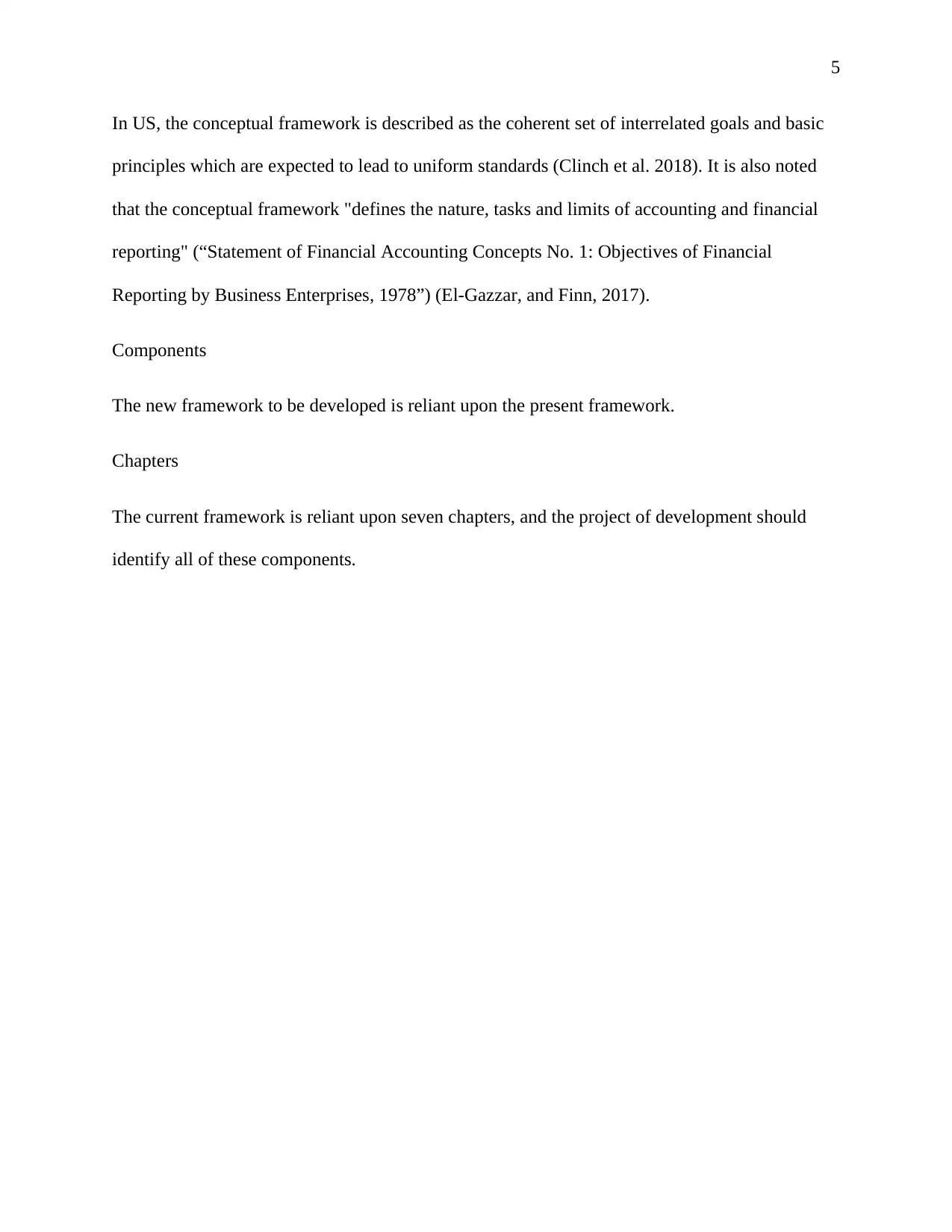
5
In US, the conceptual framework is described as the coherent set of interrelated goals and basic
principles which are expected to lead to uniform standards (Clinch et al. 2018). It is also noted
that the conceptual framework "defines the nature, tasks and limits of accounting and financial
reporting" (“Statement of Financial Accounting Concepts No. 1: Objectives of Financial
Reporting by Business Enterprises, 1978”) (El-Gazzar, and Finn, 2017).
Components
The new framework to be developed is reliant upon the present framework.
Chapters
The current framework is reliant upon seven chapters, and the project of development should
identify all of these components.
In US, the conceptual framework is described as the coherent set of interrelated goals and basic
principles which are expected to lead to uniform standards (Clinch et al. 2018). It is also noted
that the conceptual framework "defines the nature, tasks and limits of accounting and financial
reporting" (“Statement of Financial Accounting Concepts No. 1: Objectives of Financial
Reporting by Business Enterprises, 1978”) (El-Gazzar, and Finn, 2017).
Components
The new framework to be developed is reliant upon the present framework.
Chapters
The current framework is reliant upon seven chapters, and the project of development should
identify all of these components.
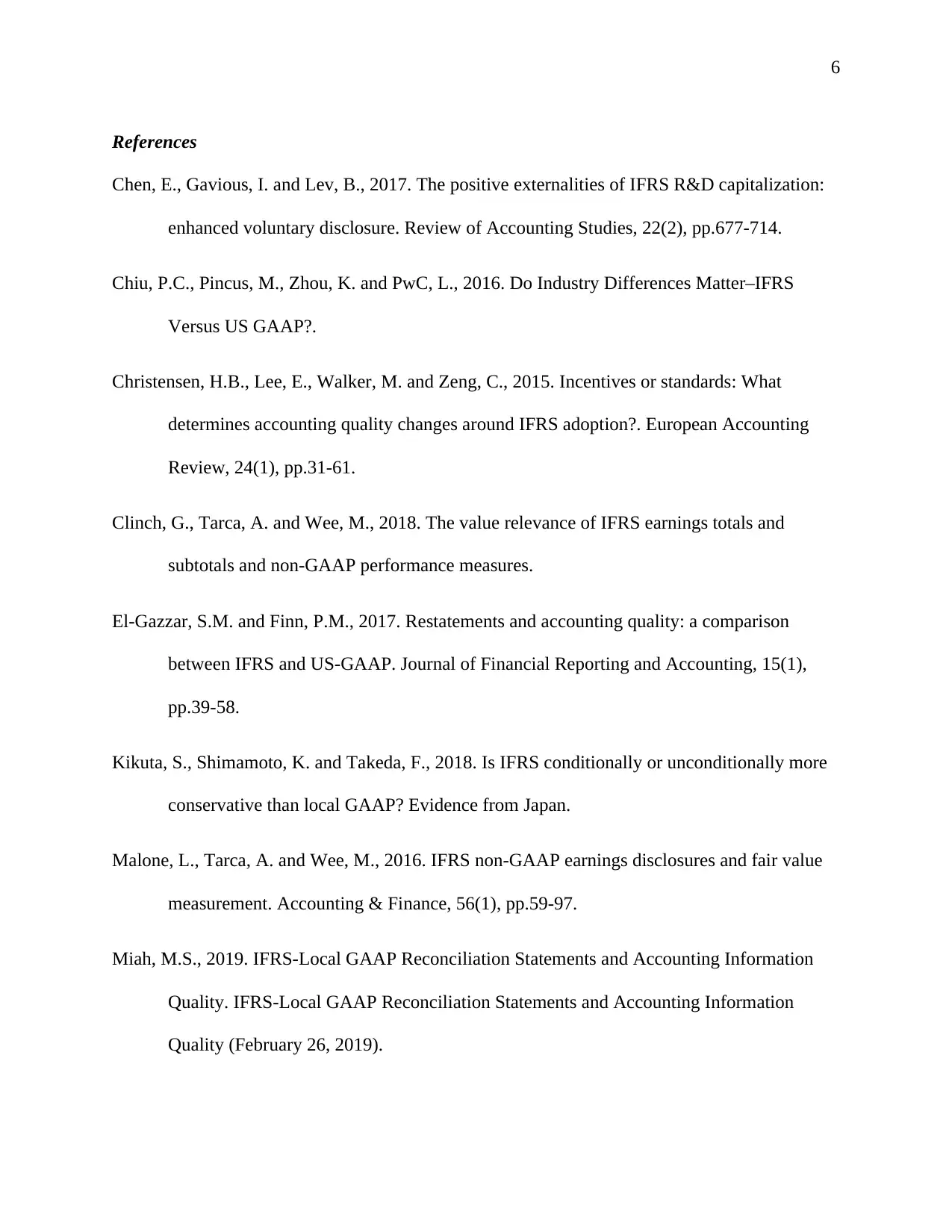
6
References
Chen, E., Gavious, I. and Lev, B., 2017. The positive externalities of IFRS R&D capitalization:
enhanced voluntary disclosure. Review of Accounting Studies, 22(2), pp.677-714.
Chiu, P.C., Pincus, M., Zhou, K. and PwC, L., 2016. Do Industry Differences Matter–IFRS
Versus US GAAP?.
Christensen, H.B., Lee, E., Walker, M. and Zeng, C., 2015. Incentives or standards: What
determines accounting quality changes around IFRS adoption?. European Accounting
Review, 24(1), pp.31-61.
Clinch, G., Tarca, A. and Wee, M., 2018. The value relevance of IFRS earnings totals and
subtotals and non-GAAP performance measures.
El-Gazzar, S.M. and Finn, P.M., 2017. Restatements and accounting quality: a comparison
between IFRS and US-GAAP. Journal of Financial Reporting and Accounting, 15(1),
pp.39-58.
Kikuta, S., Shimamoto, K. and Takeda, F., 2018. Is IFRS conditionally or unconditionally more
conservative than local GAAP? Evidence from Japan.
Malone, L., Tarca, A. and Wee, M., 2016. IFRS non‐GAAP earnings disclosures and fair value
measurement. Accounting & Finance, 56(1), pp.59-97.
Miah, M.S., 2019. IFRS-Local GAAP Reconciliation Statements and Accounting Information
Quality. IFRS-Local GAAP Reconciliation Statements and Accounting Information
Quality (February 26, 2019).
References
Chen, E., Gavious, I. and Lev, B., 2017. The positive externalities of IFRS R&D capitalization:
enhanced voluntary disclosure. Review of Accounting Studies, 22(2), pp.677-714.
Chiu, P.C., Pincus, M., Zhou, K. and PwC, L., 2016. Do Industry Differences Matter–IFRS
Versus US GAAP?.
Christensen, H.B., Lee, E., Walker, M. and Zeng, C., 2015. Incentives or standards: What
determines accounting quality changes around IFRS adoption?. European Accounting
Review, 24(1), pp.31-61.
Clinch, G., Tarca, A. and Wee, M., 2018. The value relevance of IFRS earnings totals and
subtotals and non-GAAP performance measures.
El-Gazzar, S.M. and Finn, P.M., 2017. Restatements and accounting quality: a comparison
between IFRS and US-GAAP. Journal of Financial Reporting and Accounting, 15(1),
pp.39-58.
Kikuta, S., Shimamoto, K. and Takeda, F., 2018. Is IFRS conditionally or unconditionally more
conservative than local GAAP? Evidence from Japan.
Malone, L., Tarca, A. and Wee, M., 2016. IFRS non‐GAAP earnings disclosures and fair value
measurement. Accounting & Finance, 56(1), pp.59-97.
Miah, M.S., 2019. IFRS-Local GAAP Reconciliation Statements and Accounting Information
Quality. IFRS-Local GAAP Reconciliation Statements and Accounting Information
Quality (February 26, 2019).
⊘ This is a preview!⊘
Do you want full access?
Subscribe today to unlock all pages.

Trusted by 1+ million students worldwide
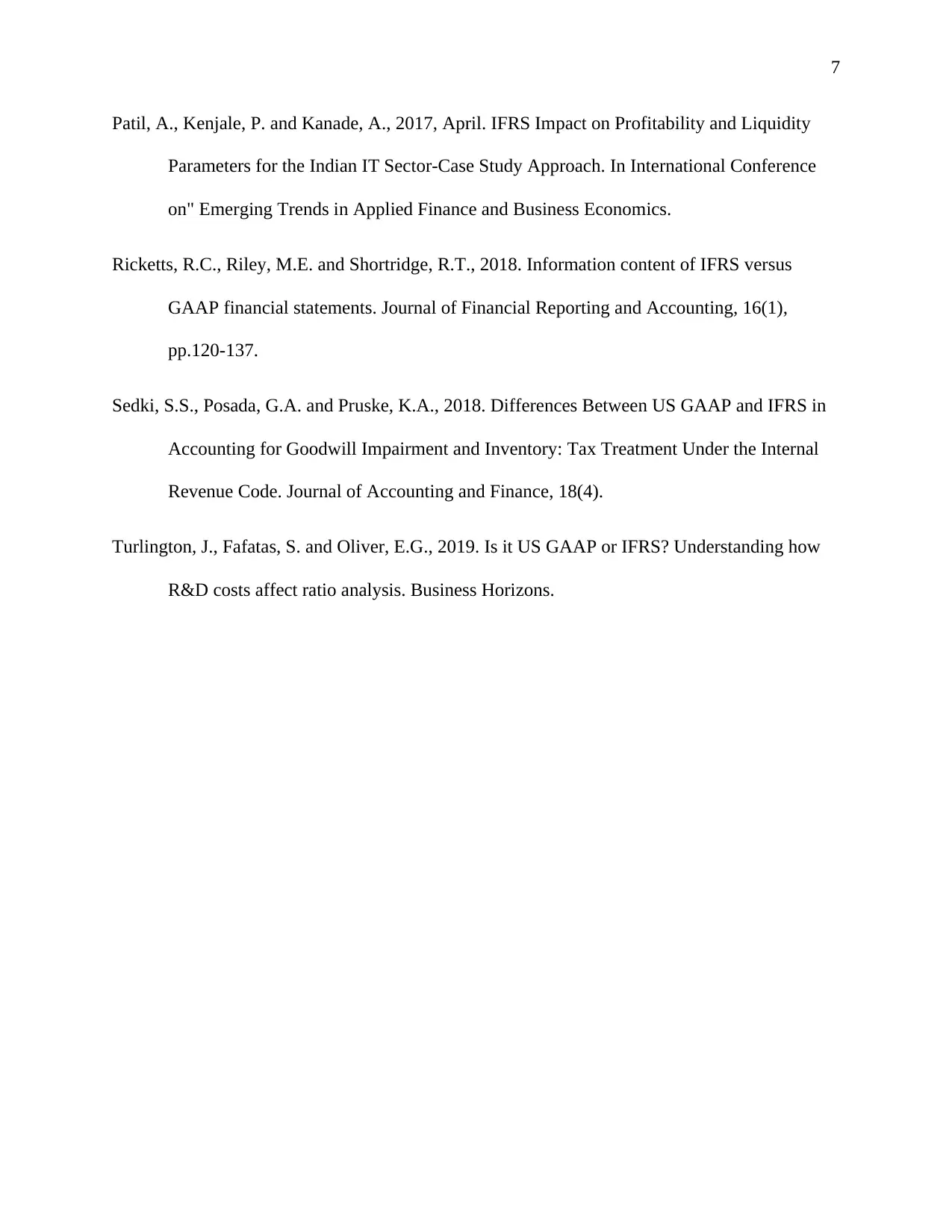
7
Patil, A., Kenjale, P. and Kanade, A., 2017, April. IFRS Impact on Profitability and Liquidity
Parameters for the Indian IT Sector-Case Study Approach. In International Conference
on" Emerging Trends in Applied Finance and Business Economics.
Ricketts, R.C., Riley, M.E. and Shortridge, R.T., 2018. Information content of IFRS versus
GAAP financial statements. Journal of Financial Reporting and Accounting, 16(1),
pp.120-137.
Sedki, S.S., Posada, G.A. and Pruske, K.A., 2018. Differences Between US GAAP and IFRS in
Accounting for Goodwill Impairment and Inventory: Tax Treatment Under the Internal
Revenue Code. Journal of Accounting and Finance, 18(4).
Turlington, J., Fafatas, S. and Oliver, E.G., 2019. Is it US GAAP or IFRS? Understanding how
R&D costs affect ratio analysis. Business Horizons.
Patil, A., Kenjale, P. and Kanade, A., 2017, April. IFRS Impact on Profitability and Liquidity
Parameters for the Indian IT Sector-Case Study Approach. In International Conference
on" Emerging Trends in Applied Finance and Business Economics.
Ricketts, R.C., Riley, M.E. and Shortridge, R.T., 2018. Information content of IFRS versus
GAAP financial statements. Journal of Financial Reporting and Accounting, 16(1),
pp.120-137.
Sedki, S.S., Posada, G.A. and Pruske, K.A., 2018. Differences Between US GAAP and IFRS in
Accounting for Goodwill Impairment and Inventory: Tax Treatment Under the Internal
Revenue Code. Journal of Accounting and Finance, 18(4).
Turlington, J., Fafatas, S. and Oliver, E.G., 2019. Is it US GAAP or IFRS? Understanding how
R&D costs affect ratio analysis. Business Horizons.
1 out of 7
Related Documents
Your All-in-One AI-Powered Toolkit for Academic Success.
+13062052269
info@desklib.com
Available 24*7 on WhatsApp / Email
![[object Object]](/_next/static/media/star-bottom.7253800d.svg)
Unlock your academic potential
Copyright © 2020–2025 A2Z Services. All Rights Reserved. Developed and managed by ZUCOL.





